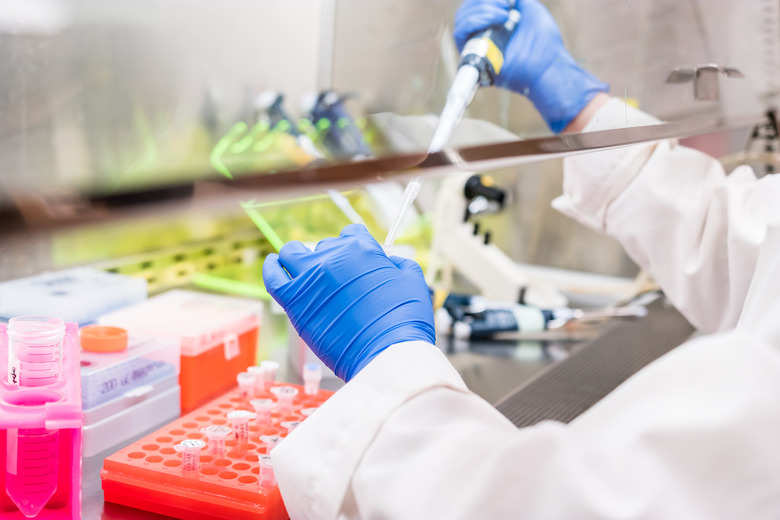How To Calculate Theoretical Yields
Say you're decorating cupcakes with sprinkles. For each cupcake, you need a handful of sprinkles. You have 12 cupcakes and two huge tubs full of sprinkles. This means that you have more than enough sprinkles to decorate all the cupcakes, but you don't have enough cupcakes to use up all of your sprinkles. The yield of the cupcake decorating reaction that you've undertaken here is thus 12 cupcakes, and it is dependent entirely upon the amount of cupcakes that you have.
In the same way, when you do a chemical reaction, the amount of product you will make will be dependent upon the component that you have less of. This component is called the limiting reagent. Once you've figured out what the limiting reagent is, you can figure out the theoretical yield, or how much product you'll be able to get from your components.
Finding the Limiting Reactant
Finding the Limiting Reactant
Take a look at the following chemical equation in which hydrogen reacted with nitrogen in order to make ammonia:
\(\mathrm{H_2+N_2\rightarrow NH_3}\)
This chemical reaction will help you figure out how much hydrogen and nitrogen are needed to make ammonia. The problem is, this equation isn't balanced. So first, balance it:
\(\mathrm{3H_2+N_2\rightarrow 2NH_3}\)
Now, you know that for every 3 moles of hydrogen, you make 2 moles of ammonia. For every 1 mole of nitrogen, you make 2 moles of ammonia.
Now, say that when doing this reaction you have 4.5 grams of hydrogen and 24 grams of ammonia. Which one is the limiting reactant?
To find this, you will need to first convert the number of grams of each component to moles. Then you can use the stoichiometric ratio given by the balanced equation to find which reactant is limiting.
To convert the mass of hydrogen and ammonia to moles, make use of the molar mass:
\(\mathrm{4.5g\enspace H_2\Biggl(\dfrac{1mol\enspace H_2}{2.02g\enspace H_2}\Biggr)= 2.2mol\enspace H_2}\)
\(\mathrm{24g\enspace N_2\Biggl(\dfrac{1mol\enspace N_2}{28.02g\enspace N_2}\Biggr)= 0.86mol\enspace N_2}\)
Given that there are 2.2 moles of hydrogen and 0.86 mols of nitrogen, which is limiting?
To figure out how many moles of nitrogen are needed to react with 2.2 moles of hydrogen, you can make use of the stoichiometric ratio given by the balanced equation:
\(\mathrm{2.2mol\enspace H_2\Biggl(\dfrac{1mol\enspace N_2}{3mol\enspace H_2}\Biggr)= 0.73mol\enspace N_2}\)
This means that in order to use up the entire 2.2 moles of hydrogen, you would need at least 0.73 moles of nitrogen.
To figure out how many moles of hydrogen are needed to react with 0.86 moles of hydrogen, you can use the same method:
\(\mathrm{0.86mol\enspace N_2\Biggl(\dfrac{3mol\enspace H_2}{1mol\enspace N_2}\Biggr)= 2.58mol\enspace H_2}\)
This means that in order to use up all 0.86 moles of nitrogen you would need 2.58 moles of hydrogen. The problem is, you don't have 2.58 moles of hydrogen! Thus, hydrogen is the limiting reactant. Once you've used up all the hydrogen you have, you cannot make more ammonia. Hydrogen is the same as the cupcakes in the example discussed earlier. Once you've decorated all the cupcakes, you'll have leftover sprinkles.
Finding the Theoretical Yield
Finding the Theoretical Yield
How much ammonia will be made if all the hydrogen you have reacts to form ammonia? This is the theoretical yield of the reaction.
\(\mathrm{2.2mol\enspace H_2\Biggl(\dfrac{2mol\enspace NH_3}{3mol\enspace H_2}\Biggr)= 1.5mol\enspace NH_3}\)
Thus, by using the limiting reagent and the stoichiometric relationship between reactant and product, you can find that the theoretical yield of ammonia is 1.5 moles.
But why is this called the theoretical yield? Why not just the yield?
The problem is that reactions don't always happen the way you think they will.
Let's go back to the cupcake decorating. Imagine that while you are decorating the cupcakes your younger sibling comes into the kitchen and steals a cupcake before you can decorate it. Well, that's one fewer decorated cupcake you can make. This is an example of a side reaction.
Chemical reactions are almost never perfect. There are usually side reactions that use your reactants to make something other than your desired product. As a result, the amount of product you would make as calculated by the limiting reagent is called the theoretical yield. In reality, your yield will probably be less than this.
Cite This Article
MLA
Gupta, Riti. "How To Calculate Theoretical Yields" sciencing.com, https://www.sciencing.com/calculate-theoretical-yields-2658/. 25 February 2020.
APA
Gupta, Riti. (2020, February 25). How To Calculate Theoretical Yields. sciencing.com. Retrieved from https://www.sciencing.com/calculate-theoretical-yields-2658/
Chicago
Gupta, Riti. How To Calculate Theoretical Yields last modified August 30, 2022. https://www.sciencing.com/calculate-theoretical-yields-2658/
